The post Luke In Kenya Part 5: Elephants, Elephants, Elephants: Kenya! appeared first on The Expeditioner Travel Site.
]]>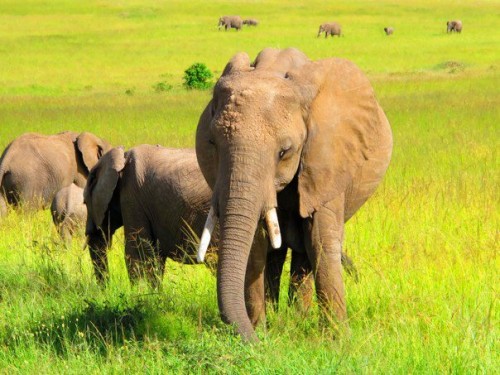
The big elephant in the room is that there is no elephant at all. I’ve been in East Africa for two months and in none of my writings have I so much as broached the subject. Matt Stabile claims he’s not mad about this lapse, just disappointed. He has good reason: I am under contract to write about elephants.
Matt and my favorite drinking game is called, “Luke, sign this stack of contracts.” Matt came up with it. Here’s how it works: you take a bunch of whiskey shots with Matt Stabile, and then he hands you a stack of contracts and you sign them and he notarizes them with his power of attorney. Sounds fun, right? Yeah, it’s a blast until you wake up one morning and Matt is wheeling your grandmother out of the nursing home claiming he owns her.
Anyways, hold onto your contraband ivory letter openers The Expeditioner readers, because my elephant silence is officially over!
Nairobbery National Park
The first time I was promised elephants was when my brothers and I traveled to Nairobi National Park. Located inside Kenya’s capital, with distant views of the city’s skyline, this makes it one of the most unique game parks on Earth.
Further separating it from its countryside counterparts is the fact that it doesn’t seem to have any animals in it. It is home to grass. And trees. My brother has taken to calling it Nairobbery National Park due to the fact that we paid a handsome sum to be there for four hours of continuous letdown. After driving 100 or so kilometers through the park, we saw a total of three animals: two ostriches and a tortoise moving at the pace of our excitement.
“We should have brought beer,” my brother said as we admired another empty field of grass and trees.
Elephant Beer, Greatest Beer on Earth
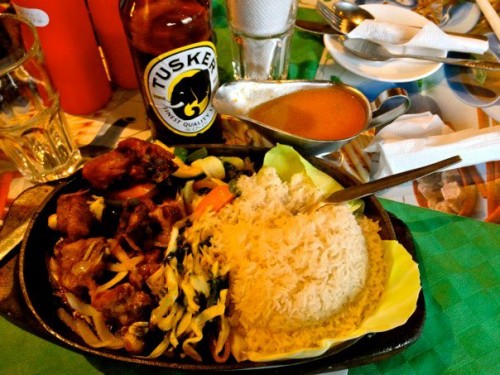
Tusker Beer — as national beers always tend to be — is the pride of Kenya. It’s also my favorite beer. Not because it tastes better than my second favorite beer, Baltica 6, but because I am a guy who appreciates a good backstory. Tusker beer is named after the elephant who killed the founder of the brewery that makes it. Also, Hemingway use to drink it like I used to devour him as a Busch Lite-swilling undergraduate beer pong champion.
Maasai Mara National Park
My next chance to see an elephant came when my brothers and I went to Masai Mara National Park on safari.
The Grand Canyon is where you go to marvel at geology. Niagara Falls is visited for by-the-book honeymooners after a boring wedding ceremony. Guatemala City is where you go to get mugged.
Maasai Mara National Park is where you go to have that clichéd, but still great, proverbial moment of paused reflection that catches a glimpse of our humanity before we broke out of the Circle of Life to check our email and update our Facebook statuses.
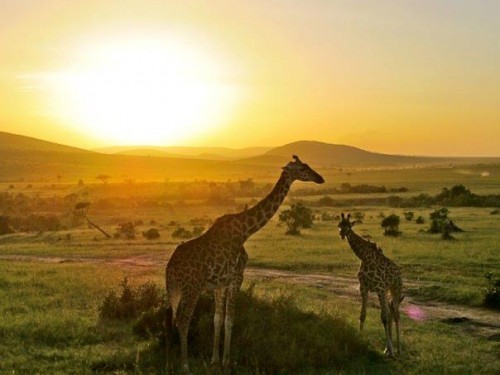
Most of the animals are friends you realize as you watch giraffes giving a nod to a herd of elephants — which are smaller than you would think they would be, but still damned majestic — and where gazelles and water buffalo hang out like barnyard pals, while wildebeests, looking insecure with with their ridiculous manes, stare longingly at hippos, wondering why the crocodiles are not interested. And then there are humans, roving around in Jeeps, capturing photos for . . . what? Facebook? Posterity?
Anthropologists change their mind a lot, but they mostly agree that at one point in our history, this was our past stomping ground too. Maybe the giraffes used to let our kids hang out with theirs.
In this line of thought, an African safari is less about discovering and more about remembering. It’s a nod to our essence, a visit to our specie’s alma mater — nostalgically rewarding — a thought as unbounded as our capacity to explore it.
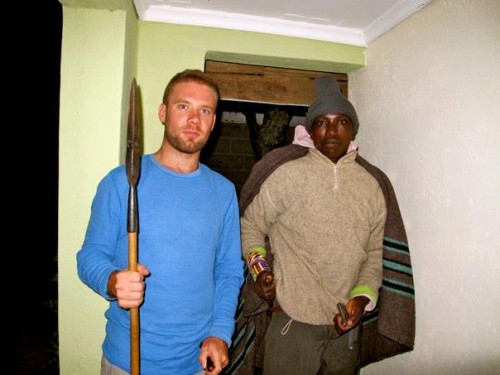
A Maasai warrior who let me hold his spear confirmed the adage that an elephant never forgets. If a person has ever upset an elephant, decades later, the animal will become unnerved at seeing that person again. An elephant also does not forgive.
I think that’s fair, even a bit human of the elephant. Unlike squirrels, who are racists and lump all seven billion of us into one category, elephants give everyone the chance to prove or disprove his/herself on an individual basis.
• Read the entire “Luke in Kenya” series here.

About the Author
 After setting out to hitchhike from Chile to Alaska, Luke Maguire Armstrong stopped in Guatemala where he spent four years directing the social service programs of the charity Nuestros Ahijados. He is the author of, iPoems for the Dolphins to Click Home About (available for sale on Amazon.com) which is especially enjoyed by people “who don’t read poetry.” (Follow Luke on Twitter: @lukespartacus). His new book, How We Are Human, was recently released.
After setting out to hitchhike from Chile to Alaska, Luke Maguire Armstrong stopped in Guatemala where he spent four years directing the social service programs of the charity Nuestros Ahijados. He is the author of, iPoems for the Dolphins to Click Home About (available for sale on Amazon.com) which is especially enjoyed by people “who don’t read poetry.” (Follow Luke on Twitter: @lukespartacus). His new book, How We Are Human, was recently released.
The post Luke In Kenya Part 5: Elephants, Elephants, Elephants: Kenya! appeared first on The Expeditioner Travel Site.
]]>The post Luke In Kenya Part 4: A Promise Stretching Through Time In Kenya appeared first on The Expeditioner Travel Site.
]]>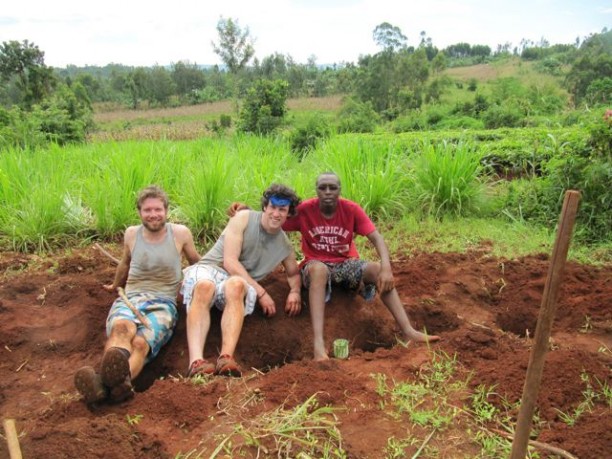
Luke in Kenya: Part 4
“Luke in Kenya” is a travel series from Managing Editor Luke Armstrong as he travels to Kenya to visit the homeland of his adopted brother.
We wake up early on the first day of construction to a brief breakfast of fry bread and coffee just as the sun throws hints of its rise on the horizon. No winter comes here in Kisii, Kenya, and in every direction are miles of green hills kept lush by frequent rains.
On the way to the building site, Calvin points to a row of trees reaching 50 feet into the air. “I planted those,” he says, “just before I came to the U.S.”
These are the physical markers of passing time. Other markers, less physically dramatic, paint a fuller picture of his story. These include Calvin and Joash’s diploma from Saint Mary’s Central High School; Calvin’s four-year college degree from The University of Mary; Joash’s NCAA track and cross country trophies and countless other markers stretching a decade into the past.
Our presence here today on a building site and Calvin’s return are other markers that tell his story.
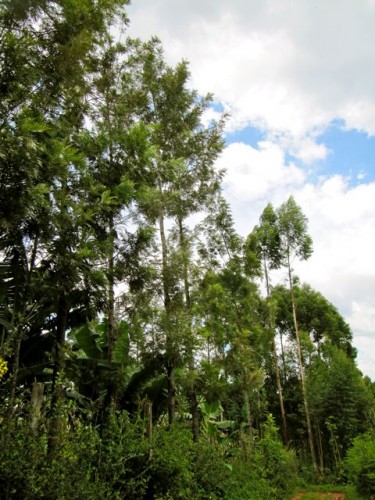
Against the Odds
When I was in high school my parents took in Calvin and then his brother Joash, two orphans from Kenya. My parents were not seeking to adopt, but were not opposed to it when Evan Beauchamp, the missionary leading the Bismarck Diocesan Mission, asked them if they would.
After reading a book that planted the seed of a dream in Calvin, he’d spent the last year petitioning Evan to take him to the United States, where he wanted to study to become a doctor — a pipe dream for an orphan in a poor village in rural Kenya.
Initially, Evan told Calvin this was not possible. But if Calvin can be characterized as anything, it is persistent. After a year of pleading, Evan relented and said he’d see what he could do. He knocked on a lot of doors that didn’t open. Finally, he thought of my family, his thinking being, well the Armstrongs already have eight kids, what’s one more?
A New Home in Kenya
It wasn’t our original impetus for coming to Kenya, but after we read an e-mail from Calvin, it became our raison d’être to make the trip. Calvin had just finished medical school in the Caribbean and was back in Kenya to get a visa for his clinical rotations in the U.S. While back in his native village, he met two AIDS orphans, Samuel (15) and Simon (13), a half-kilometer from where he and his brothers had been orphaned by the same cause.
These two brothers were being looked after by their grandparents who gave them all they could, which amounted to a place to sleep and a meal a day, but not enough not keep them in school.
Calvin sent an e-mail to rally the troops. Everyone in our family got on the fundraising horn: my dad on the radio, my mom writing, me blogging; even my brother John, who is Simon’s age, helped by donating some of his Christmas money for the boys to buy books. Enough was directed to the Diocesan Mission to build the orphans a house and put them in a good school. My brother, Tyler, and I left for Kenya to meet Calvin, packing our work boots, ready to assist in the construction in a home for Samuel and Simon.
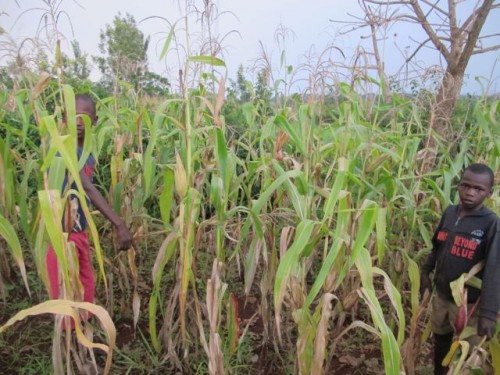
Samuel and Simon
We met Samuel and Simon the evening after the first day of construction. “My father is buried here,” Samuel informed us, pointing to a vegetable garden where beans had just sprouted. A few yards away he pointed to a patch of Napier grass, the kind they feed to cows. “My mother is buried there.”
He signaled to the graves without emotion, despite the fact that he was discussing the final resting place of both his parents. His father died in 2005; his mother in 2010. Both were victims of AIDS.
Tyler, Calvin and I followed the two boys down a narrow, muddy trail to their grandparent’s house. Their grandfather is a graying man who supports himself with a cane. Their grandmother is a trembling woman with a strained gait. Both carry solemn expressions and seem to know that they won’t be around much longer to look after their parentless grandchildren.
We arrived at their grandparents’ home just as the sun was setting and were seated around a battered table in their mud hut. The cicadas began their song, one that would grow in volume as the darkness increased.
When night fell fully, we were left in darkness. There were no streetlights outside and no artificial illuminations — complete and utter darkness broken only by our voices and the cicada’s song.
“You see,” Calvin said, “they don’t have a way to do their homework after dark. They can’t even afford candles.”
Calvin turned to me to indicate I begin the meeting. It was as solemn as an occasion as I’d ever attended. On both sides of the table, promises whose obligations would extend for years were made.
With Calvin translating, I explained to the two boys that Calvin’s parents had also died of AIDS. “Joash and Calvin,” I said, “are my brothers who grew up in this village. Now, Joash is studying to be a nurse and Calvin a doctor.”
“What do you want to be when you grow up?” I asked them. Samuel, the oldest, said he wanted to be a doctor. Simon said he wanted to be a pilot. Life’s deck is stacked considerably against either profession, but the same could have been said of Calvin and Joash’s plans a decade ago.
“My brothers and I are going to make a promise to you,” I told them. “We promise to make sure you have enough money to stay in school — the best school here — if you promise to stay in school, work hard and get good grades.”
“You have to get the best grades,” Calvin interjected, “number one and number one.”
In the darkness, both boys nodded and promised this. They shook my hand, then Calvin’s and finally Tyler’s. Their grandfather rose slowly from his chair and they shook his hand.
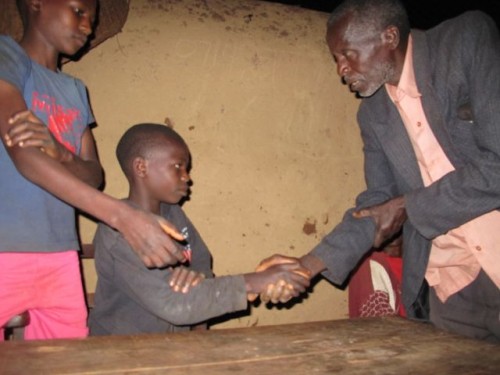
These were not the whimsical bargains of children, but the solemn promises of men who understood what their vow entailed.
Our agreement on both sides made, the boys told us what they remembered about their parents. In African culture, the dead and the living walk together. Those living carry the spirit of those who have passed on.
Both boys remember what their mother told them before she died. “I am sick,” she told them, “but you are well. If you walk humbly, stay away from bad influences and get an education, you will be okay.”
Then the boy’s uncle told Calvin a story about his mother that he’d never heard. After their father died, Calvin and Joash sometimes stayed with relatives and their mother would have to stay home alone. She was afraid of the dark — as many here are — worried of witches and other dangers, real and imagined, that lurk in the African night. Someone from Simon and Samuel’s family used to come and stay with her so that she would not be afraid.
Calvin smiled and let out a hearty chuckle. “I never knew that. Wow.” For an orphan, any new story about a parent is grasped for and held dear.
Today, we don’t know how Samuel and Simon’s story ends. But we know that now they have a home and enough support to attend school. We believe they are serious in their promise to work hard towards a life free of the disparaging poverty common in this region. We hold the hope that 10 years from now, when trees planted today tower 50 feet above the earth, Simon and Samuel will be where they dream to be.
• Read the entire “Luke in Kenya” series here.

About the Author
 After setting out to hitchhike from Chile to Alaska, Luke Maguire Armstrong stopped in Guatemala where he spent four years directing the social service programs of the charity Nuestros Ahijados. He is the author of, iPoems for the Dolphins to Click Home About (available for sale on Amazon.com) which is especially enjoyed by people “who don’t read poetry.” (Follow Luke on Twitter: @lukespartacus). His new book, How We Are Human, was recently released.
After setting out to hitchhike from Chile to Alaska, Luke Maguire Armstrong stopped in Guatemala where he spent four years directing the social service programs of the charity Nuestros Ahijados. He is the author of, iPoems for the Dolphins to Click Home About (available for sale on Amazon.com) which is especially enjoyed by people “who don’t read poetry.” (Follow Luke on Twitter: @lukespartacus). His new book, How We Are Human, was recently released.
The post Luke In Kenya Part 4: A Promise Stretching Through Time In Kenya appeared first on The Expeditioner Travel Site.
]]>The post Luke In Kenya Part 3: The Happiest Man in Mombasa appeared first on The Expeditioner Travel Site.
]]>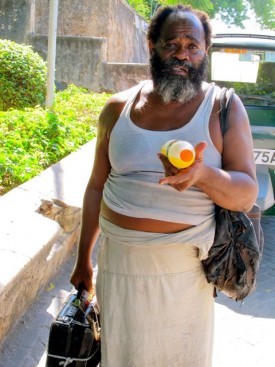
Luke in Kenya: Part 3
“Luke in Kenya” is a travel series from Managing Editor Luke Armstrong as he travels to Kenya to visit the homeland of his adopted brother.
He’s always going, but never arrives.
They call him “The Traveler.” He’s a familiar face along the sunny streets of Old Mombasa. His unique blend of exotic joy fits in the postcard-environment of the city. In his right hand he carries an old leather briefcase filled with books — bursting at the seams and intact only due to twine tied around its frame. Dangling from his left shoulder is an ancient green backpack. His dress is a tunic made from recycled canvas. A faded return address can just be made on out from a time when the fabric protected (presumably) a crate being shipped from a far-off destination.
I passed him without noticing when my group of haphazardly assembled travelers left Fort Jesus to find a restaurant. Michelle, a woman from South Sudan, pointed him out and told me the handful of details she’d gleaned during her two-week stay in Mombasa.
“They call him The Traveler,” she told me — one of my trigger words.
“I’ll catch up with you later,” I said to the group, finding nothing more appealing at that moment then finding myself in a conversation with him.
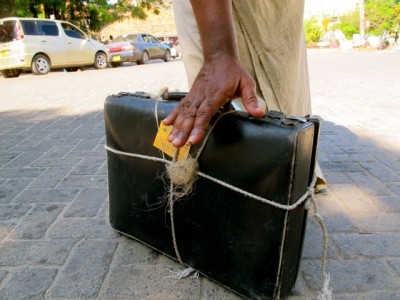
When I reached the intersection where he had disappeared, I asked a woman selling soft drinks which way The Traveler had gone.
“That way,” she pointed, knowing whom I meant.
When I approached him, he shook my hand and pointed to my camera and them himself. I asked if I could record him. “Sure, sure, yes,” he said, nodding.
Much of what he said didn’t make sense. “And the waters cold in the villages . . . I can’t, I can’t, I can’t do that. You can go while it is, it’s okay, it’s alright . . . bring me what is, you can read the lesson.” But his voice had a certain melody to it as it switched from one language to gibberish to another. Like a good song heard for the first time, when it stopped I wanted to hear it again and again. The vendors around said the same thing about him, “He’s a happy, happy man.”
I’ll vouch for that. He’s maybe one of the happiest.
“He has no home,” another vendor told me.
“He’s a very educated man,” said a third, “but one day he just went . . . ” the man circumscribed the circumference of his ear, pantomiming the universal sign for loony.
A police officer on the beat told me he never had any trouble with The Traveler, who he called “Bob.” He also said that Bob was always happy.
The vender who told me he was well educated told me to go to a café named Yahazi’s and ask him to tell me a story about him. I didn’t end up making it there and will have to save it for the if and when I return to Mombasa. One never knows which road will lead you back to where you started.
I realize this isn’t much, and this may all I never know about The Traveler: one tiny glimpse. But I’m glad he’s out there, a traveler caught in a loop, never leaving but always going, and blissfully content with that. There are metaphors in that, but I’ll leave you the reader to fill in your own.
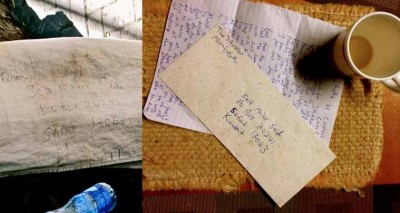
This story does not end completely here. I have no idea how long ago that return address was written on what is now The Traveler’s tunic. Maybe that P. O. Box in Kuwait City is still in existence — maybe not. Maybe it’s being used by the same person — maybe another. Whatever the case, I’ve addressed an envelope to it. Inside I’ve printed one of my favorite travel poems, “Ithaka” by Constantine Cavafly. Though The Traveler may never end up making it to the airport, he’s still at least inspired this letter to be sent to the Kuwait address. I’ll send it via airmail.
• Read the entire “Luke in Kenya” series here.

About the Author
 After setting out to hitchhike from Chile to Alaska, Luke Maguire Armstrong stopped in Guatemala where he spent four years directing the social service programs of the charity Nuestros Ahijados. He is the author of, iPoems for the Dolphins to Click Home About (available for sale on Amazon.com) which is especially enjoyed by people “who don’t read poetry.” (Follow Luke on Twitter: @lukespartacus). His new book, How We Are Human, was recently released.
After setting out to hitchhike from Chile to Alaska, Luke Maguire Armstrong stopped in Guatemala where he spent four years directing the social service programs of the charity Nuestros Ahijados. He is the author of, iPoems for the Dolphins to Click Home About (available for sale on Amazon.com) which is especially enjoyed by people “who don’t read poetry.” (Follow Luke on Twitter: @lukespartacus). His new book, How We Are Human, was recently released.
The post Luke In Kenya Part 3: The Happiest Man in Mombasa appeared first on The Expeditioner Travel Site.
]]>The post Luke In Kenya Part 2: Nairobi’s Kibera Slum [Photo Essay] appeared first on The Expeditioner Travel Site.
]]>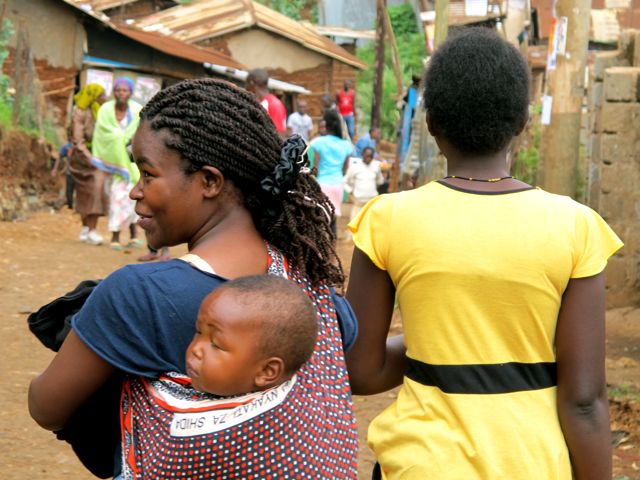
Luke in Kenya: Part 2
“Luke in Kenya” is a travel series from Managing Editor Luke Armstrong as he travels to Kenya to visit the homeland of his adopted brother.
Nairobi’s Kibera slum is Africa’s second largest. Most families subsist on less than $1 a day. Though present (and often highlighted by the media and NGOs), desperation is not the rule here. By our Western standards, Kibera is a place with atrocious living conditions. But most here are there by choice, escaping hungry conditions in the countryside to find opportunities and work. It reminds me of the 1860’s New York as portrayed in Gangs of New York. In Kibera you find excitement; hustle and bustle. As the Economist aptly pointed out, “Kibera may be the most entrepreneurial place on the planet.”
Kibera is by no means an easy place to live. To fill your belly, every day requires hard work and ingenuity.

Kibera’s populations swells and contracts from 600, 000 to 1.5 million. They often shrink during elections years (March 4, 2013, is the next one) when tensions between the 42 different tribes cause people to get out of Dodge.
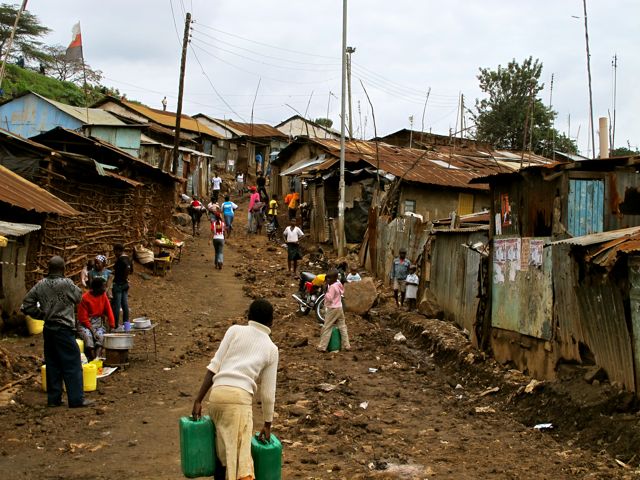
The first thing you see when you walk out of your house in Kibera is your neighbor. Families, sometimes as large as eight people, live in a single room. Up to 100 families will share a latrine. Because of the price to empty them, these overused latrines often overflow. When this occurs, some families resort to defecating in plastic bags that at night they throw into the street. These are aptly called “flying toilets.”
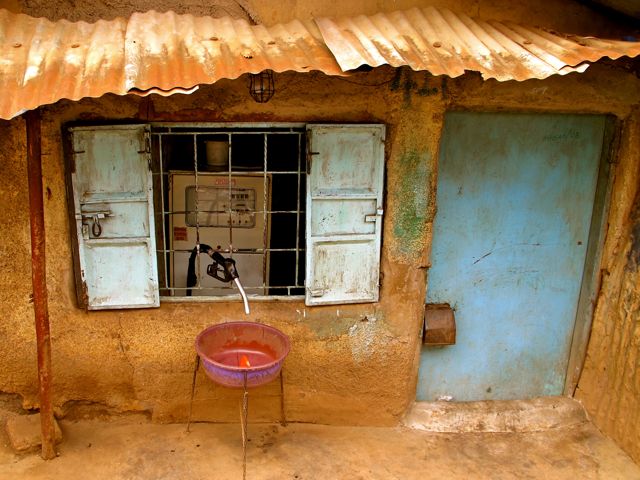
There are two parts of Kibera: the legal and the illegal. In the illegal side, fires are a constant threat due to indoor cooking practices inside the cluttered mud huts.
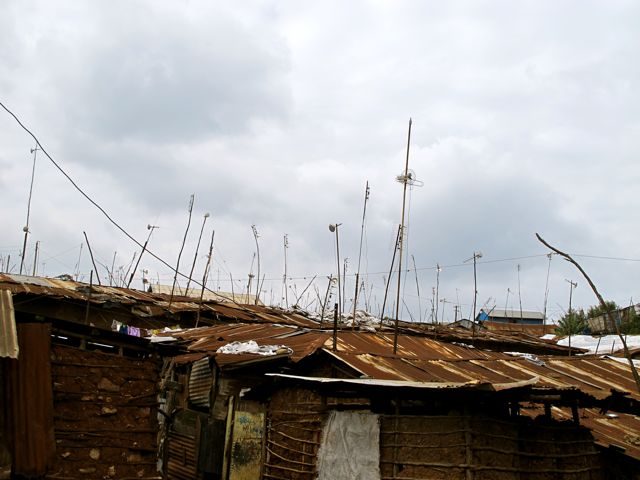
When it rains, the haphazardly connected electrical wires are a major threat, often resulting in injury and death.

Kibera has an open sewage “system.” The plastic water pipes that run over the raw sewage often develop holes, resulting in contamination.
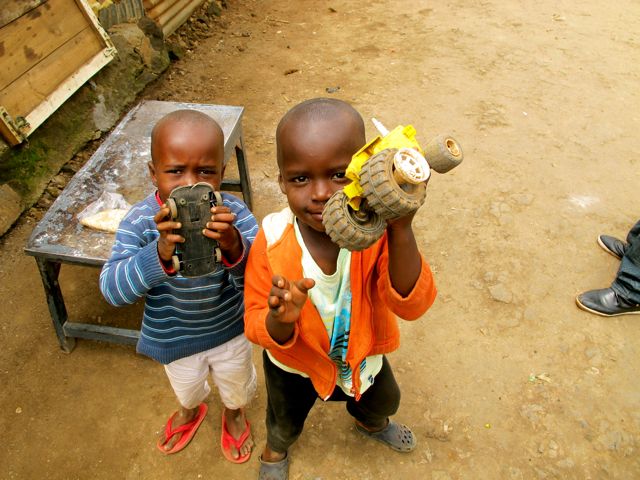
But, of course, kids enjoy toy cars in Kibera as they would anywhere.
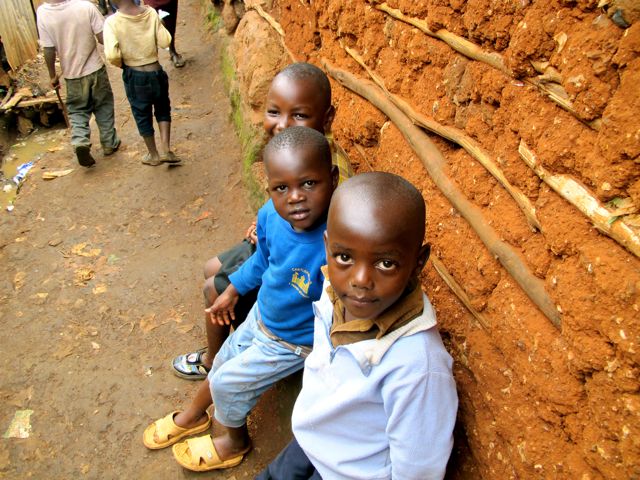
According to one resident, “Everyone comes to the slum through another person. You can’t just come today and start living. No one would accept you.”
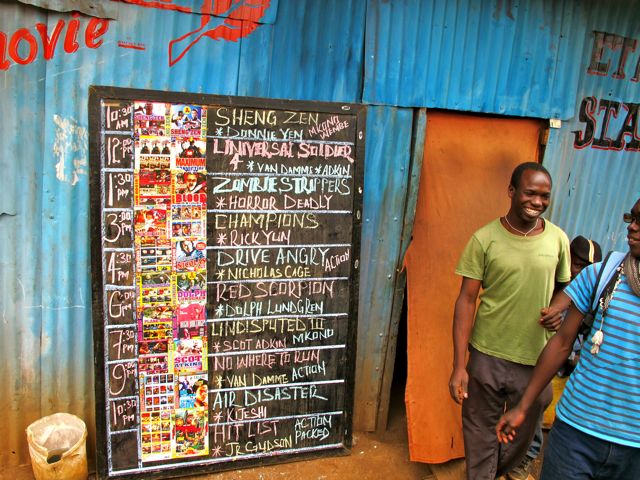
For entertainment, a mere 40 cents will allow you to catch a flick in Kibera.
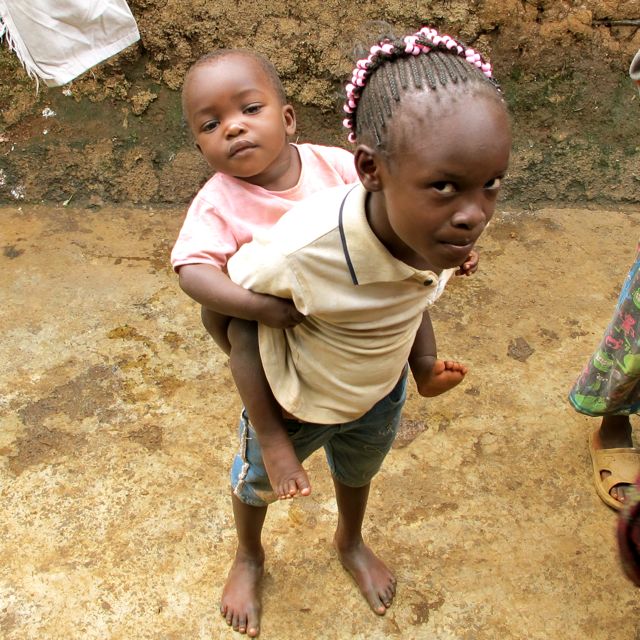
There is no police station inside the slum. They are located outside. “For them to follow your case, you need to bribe them,” one resident informed me. Normally they go to the chief.
• Read the entire “Luke in Kenya” series here.

About the Author
 After setting out to hitchhike from Chile to Alaska, Luke Maguire Armstrong stopped in Guatemala where he spent four years directing the social service programs of the charity Nuestros Ahijados. He is the author of, iPoems for the Dolphins to Click Home About (available for sale on Amazon.com) which is especially enjoyed by people “who don’t read poetry.” (Follow Luke on Twitter: @lukespartacus). His new book, How We Are Human, was recently released.
After setting out to hitchhike from Chile to Alaska, Luke Maguire Armstrong stopped in Guatemala where he spent four years directing the social service programs of the charity Nuestros Ahijados. He is the author of, iPoems for the Dolphins to Click Home About (available for sale on Amazon.com) which is especially enjoyed by people “who don’t read poetry.” (Follow Luke on Twitter: @lukespartacus). His new book, How We Are Human, was recently released.
The post Luke In Kenya Part 2: Nairobi’s Kibera Slum [Photo Essay] appeared first on The Expeditioner Travel Site.
]]>The post Luke In Kenya Part 1: Flying Into A New Year/World appeared first on The Expeditioner Travel Site.
]]>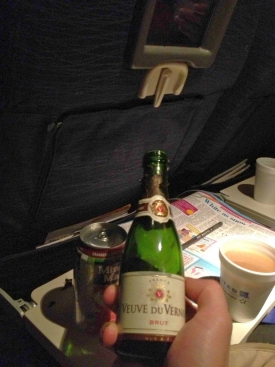
Luke in Kenya: Part 1
“Luke in Kenya” is a travel series from Managing Editor Luke Armstrong as he travels to Kenya to visit the homeland of his adopted brother.
Two days before my departure, my adopted Kenyan brother wrote (succinctly I may add), “Hey Luke, I just realized that you really suck at making a flight itinerary.” He was right. I flew out of Minneapolis at 5 p.m. on December 31 and arrived in Nairobi at 4 a.m. on January 2, connecting in Chicago, London and Cairo before my plane-weary body touched down in Nairobi. There are better ways to make this trip.
But I looked forward to two days in a limbo I’ve learned to love: airports. Flights lend themselves to a revealing sort of reflection — a contemplation of the place left and consideration of the destination to come. Each flight was filled with a distinctive cast of characters. A flight attendant on my MSP-CHI leg had a dress hanging in the airplane’s closet so that she could rush a few minutes late to a wedding reception upon arrival. She kindly gave me two free drink vouchers for my CHI-LON leg. “If you’re going to be flying over New Year’s Eve, you should probably have some champagne on the house,” she told me.
On my CHI-LON leg I sat next to Trace, a woman who shared my champagne and unabashedly told me how the best day of her life was when her son turned 18 and left the nest for good. “Some people should never be mothers,” she said. “He’s a sweet kid, and I was kind to him. It’s great having him now, but if I could do it over again, I would have never been a mother.”
Trace was on a way ticket to meeting her British boyfriend on his turf. The last hour of the eight-hour flight she spent fixing her makeup in anticipation of her amorous rendezvous. He promised to meet her cab from the airport with chilled champagne to toast the new year and their new life together. “I don’t know how I’ll do it,” she said, “but I’m not going back to Ohio.”
Flying form London to Cairo on Egypt Air I sat next to Lucha — an woman in her seventies wearing a gaudy collection of glittering gold jewelry. When I inquired about her family, she told me without emotion, “I’m sorry to tell you this, but they are all dead.” Later, when she opened up and her frowned turned to light laughter, she told me about her granddaughter, making me doubt the veracity of her earlier statement. This flight was also the only one I’d been on where a group of children were allowed to run up and down the aisle of the plane.
“That woman is from Somalia,” Lucha said, pointing out a large woman in a hijab. Later she waved this stranger over and said something in Arabic to her. “I told her,” she translated, “to run up and down the aisle to lose some weight. I think she is pregnant.”
On my last leg — a full day after I’d left the U.S. — I sat next to Steve, a 21-year-old American Political Science major who was six months into his gap year in Jordan. “I’m not supposed to be speaking English,” he informed me. “Arabic is a tough language and I signed a contract to only speak Arabic for a year.” But, since he was on vacation and spending two weeks in Kenya, he decided that English was okay.
*
When I arrived I went straight to the ATM, which promptly ate my card. I’d retrieve it later that afternoon from the bank after several calls and plenty of “uh-oh” thoughts.
When my brother Calvin arrived at the airport at 5 a.m. to meet me, he introduced me to his cousin Anita, part of my brother’s family I had come to Kenya to know, since in a way, they are also part of my family.
“Welcome to Kenya. Our cab driver is being arrested,” he said as he we walked out to the road. “They’ll release him soon. They’re just looking for a bribe. The police here would sell their own mothers for money.”
When our cab driver returned, we’d barely pulled out of the parking lot before the police detained him again. This time they told him his vehicle was not roadworthy. But 200 Kenyan shillings helped make it legal again. My brother laughed, “They saw that now he had a Muzungu (a foreigner) and figured he was now good for some more money.”
In the remaining darkness of night, our driver put his un-roadworthy vehicle in gear and we headed for Calvin’s uncle’s house, where I’d be staying for 10 days in Nairobi until my other brother Tyler arrived and we departed for the village where Calvin grew up. Until then, time for this Muzungu to explore.

• Read the entire “Luke in Kenya” series here.
About the Author
 After setting out to hitchhike from Chile to Alaska, Luke Maguire Armstrong stopped in Guatemala where he spent four years directing the social service programs of the charity Nuestros Ahijados. He is the author of, iPoems for the Dolphins to Click Home About (available for sale on Amazon.com) which is especially enjoyed by people “who don’t read poetry.” (Follow Luke on Twitter: @lukespartacus). His new book, How We Are Human, was recently released.
After setting out to hitchhike from Chile to Alaska, Luke Maguire Armstrong stopped in Guatemala where he spent four years directing the social service programs of the charity Nuestros Ahijados. He is the author of, iPoems for the Dolphins to Click Home About (available for sale on Amazon.com) which is especially enjoyed by people “who don’t read poetry.” (Follow Luke on Twitter: @lukespartacus). His new book, How We Are Human, was recently released.
The post Luke In Kenya Part 1: Flying Into A New Year/World appeared first on The Expeditioner Travel Site.
]]>